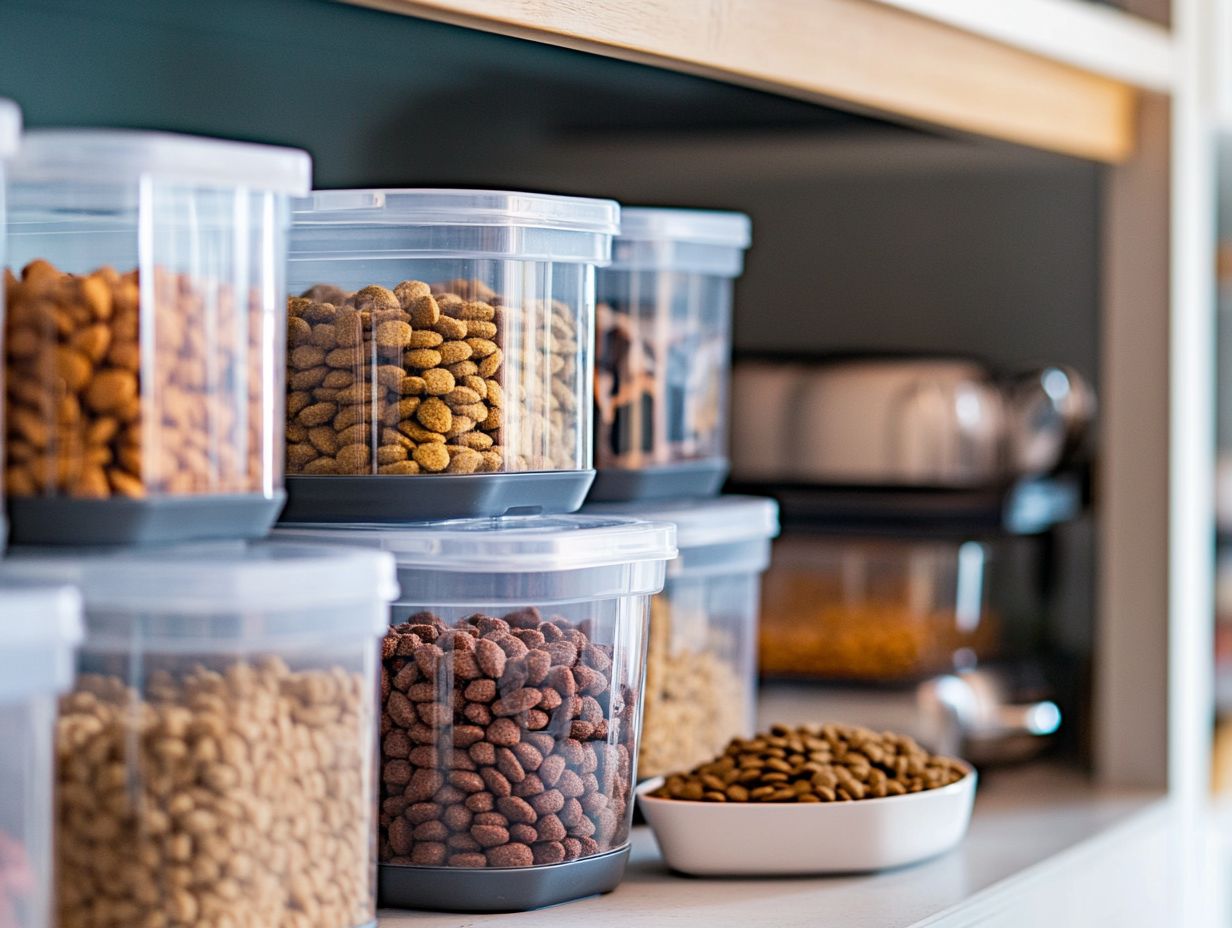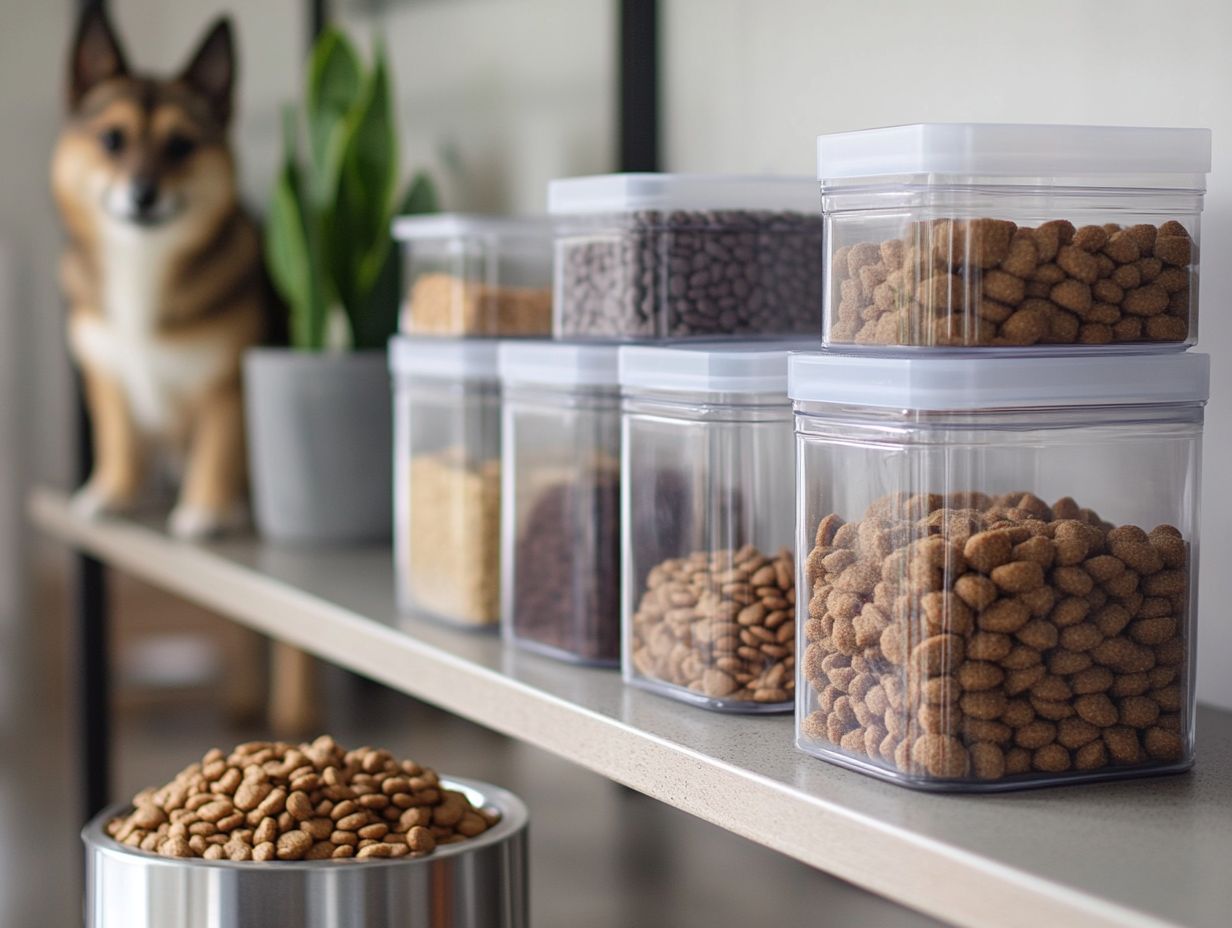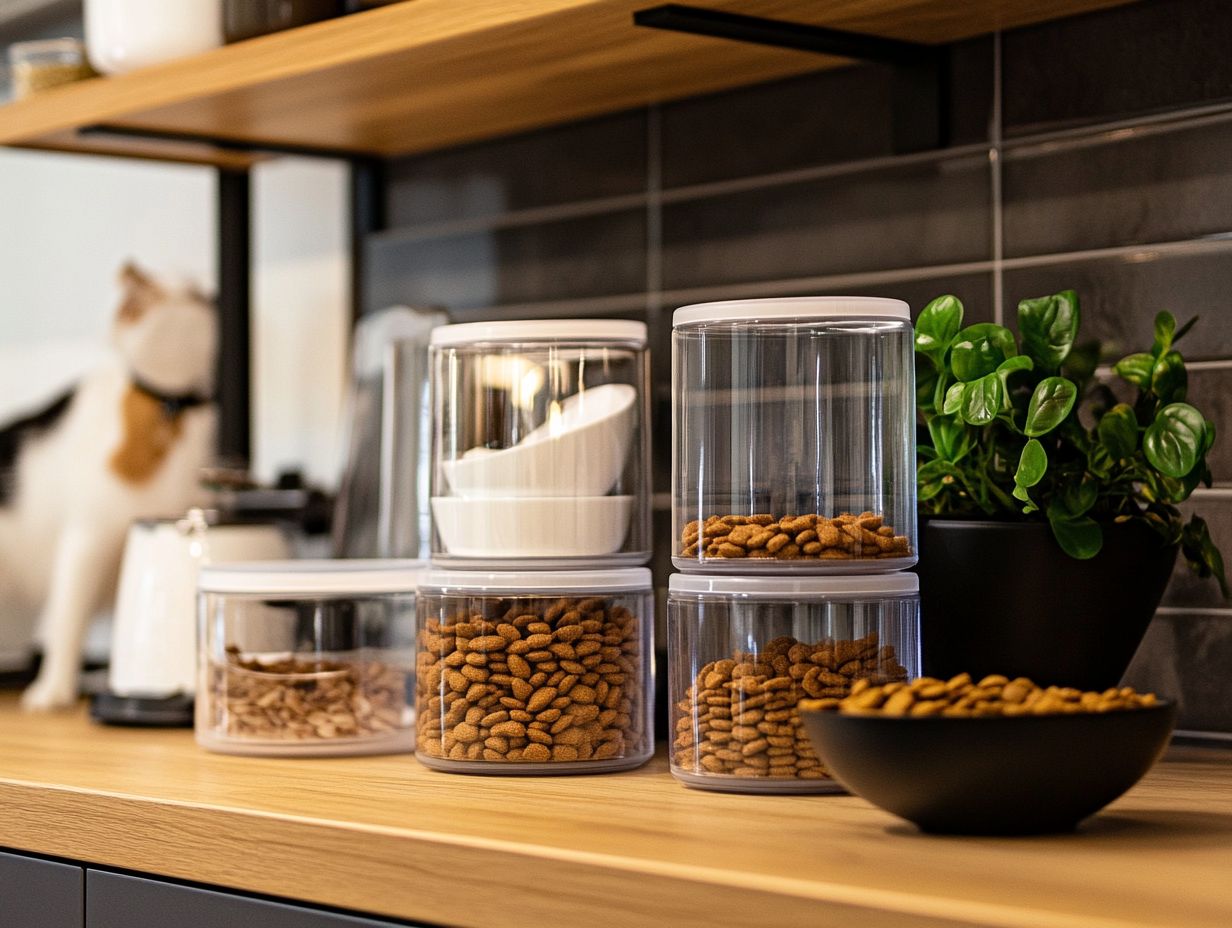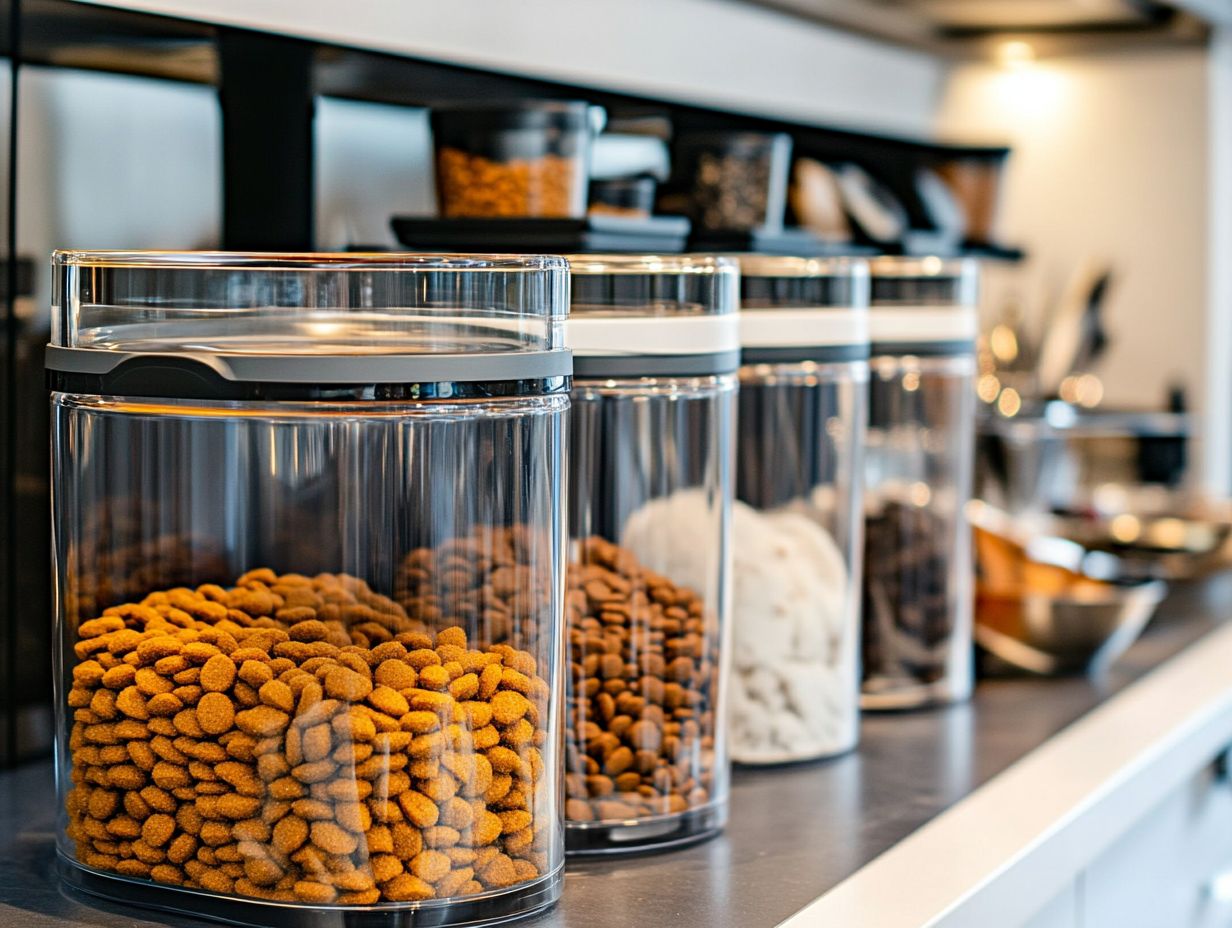Proper storage of your pet’s food is crucial for their health and well-being. Just like we need fresh ingredients, our furry friends deserve the same quality food, ensuring nutritional adequacy, which is vital for their health.
Storing their food properly can prevent spoilage, maintain nutritional value, and keep pests such as rodents and insects at bay, ensuring food safety and extending the shelf life. Regularly inspect containers for signs of spoilage or pest activity.
Discover essential tips for storing your pet’s food, signs that indicate it may not be safe, and best practices for feeding, including insights on pet food storage and handling, while also monitoring food for potential allergens and toxic ingredients, especially for cats with known sensitivities.
By following these guidelines, you can ensure your pet enjoys every meal to its fullest!
Key Takeaways:

Why Is Proper Storage Important for Your Pet’s Food?
Proper storage of your pet’s food is essential for their health and the quality of the nutrition they receive. When pet owners neglect proper food storage protocols, they risk introducing contaminants or creating conditions that can lead to health issues, ultimately affecting their pet’s overall well-being. For instance, improper food storage may result in malnutrition due to decreased protein, vitamin, or caloric intake. For cats, this may lead to deficiencies in taurine and amino acids, which are crucial for their obligate carnivore dietary needs. Food spoilage is also a significant concern, especially with canned or frozen food items that can become unsafe for pets to consume.
Adhering to proper storage conditions, understanding shelf life, and following food packaging guidelines are crucial for maximizing nutritional value and minimizing spoilage. This approach ensures that pets receive high-quality dry, canned, and frozen food, promoting healthier behaviors overall among pets and pet owners.
How to Properly Store Your Pet’s Food?
Properly storing your pet’s food involves several best practices that not only extend the product’s shelf life but also maintain its quality and safety for your pets.
These practices include:
- Using airtight containers
- Avoiding the removal of food from its original packaging whenever possible
- Checking the integrity of food packaging upon purchase, looking for any damage that might compromise food safety.
- Adhering to the manufacturer’s storage recommendations to prevent spoilage and maintain freshness
By following these guidelines, you can ensure that your pets receive the highest quality products and avoid issues related to expired pet food.
1. Keep It in Its Original Packaging
Storing pet food in its original packaging is the best way to maintain maximum freshness and quality. The packaging protects the food from environmental contaminants and typically includes the expiration date and recommended storage conditions. This helps preserve the food’s nutritional value and prevents spoilage or pest infestations, both of which can be harmful to pet health.
Along with offering protection from environmental factors, original packaging provides pet food caretakers with essential information about nutritional values and portion guidelines, which are crucial for ensuring balanced diets for our pets. Understanding the specific dietary needs of different life stages (kittens, adults, seniors) is important when determining how much food to feed, as this will help avoid over- or underfeeding.
Many packaging designs also feature resealable options that help keep the food fresh for a longer period, promoting optimal feeding practices and supporting our pets’ overall health. By adhering to these practices, pet owners can help ensure the longevity and vitality of their beloved companions.
2. Use Airtight Containers
Airtight food containers for opened dry food are essential for keeping food fresh by protecting it from air, moisture, and pests. These containers not only promote food safety but can also extend the shelf life of your pet’s food, allowing them to enjoy their meals without concerns about their well-being. Additionally, it is important to clean containers regularly to prevent bacterial growth and contamination, particularly for wet food items.
Finally, consult with your veterinarian regarding proper dietary practices, especially if your cat has specific health concerns or dietary restrictions.
When searching for the best storage solution for cat food, consider which material is most suitable for maintaining its nutritional integrity. Plastic, metal, and glass are all functional options. Plastic is lightweight and comes in a wide range of sizes, while metal is highly durable and resistant to pests. Glass offers the advantage of visibility and does not absorb odors.
In terms of size, a container that holds a week’s worth of food is often ideal, as it minimizes the frequency of opening. Using an airtight container reduces the risk of cross-contamination, thereby preserving the nutrition of cat food and overall health.
3. Store in a Cool, Dry Place
Storing cat food in a cool, dry place is essential for preserving its quality and preventing spoilage, as temperature and humidity are two major factors that affect food integrity.
Creating optimal storage conditions is crucial to ensure that cats receive the highest quality food, which in turn positively impacts their overall health and well-being. It is recommended to store cat food at a temperature between 10°C and 21°C (50°F and 70°F), with humidity ideally kept below 15%.
Cat food should be kept away from direct sunlight and heat sources, such as radiators or ovens, as these can accelerate degradation and promote mold growth. Monitoring storage conditions can be as simple as regularly checking humidity levels with a hygrometer or placing the food container in a dark, cool cabinet.
This mindful approach not only extends the shelf life of cat food but also protects cats from the health risks associated with spoiled and improperly stored food. Always consult a veterinarian when selecting storage practices for specific diets, especially for cats with health conditions.
4. Do Not Mix Old and New Food

Mixing old and new cat food can lead to inconsistencies in freshness, nutritional value, and safety. Therefore, it is crucial for pet owners to adopt the first-in, first-out principle when managing their cat food inventory.
Ensuring that older food is consumed before newer supplies reduces the risk of expired cat food and maintains the integrity of the nutrients provided. To implement this system effectively, it is important to use containers clearly marked with the purchase date, making it easy to identify older food.
Proper storage of cat food that allows for easy visibility of the dates can help minimize waste. Regularly checking the freshness of each batch further avoids wastage, and organizing cat food by expiration dates promotes better practices.
Additionally, maintaining an inventory checklist can assist in tracking supplies and ensuring smooth rotation.
Identifying Spoiled Cat Food
Signs of spoiled or improperly stored cat food can be easily identified and include the following:
- Mold Growth: The presence of mold on cat food is a clear indication of improper storage. If you notice mold, dispose of the food immediately in a sealed bag to prevent contamination, as it can cause vomiting, diarrhea, and potentially even death.
- Rancid Smell: A rancid odor emanating from your cat’s food signifies that it has spoiled and is no longer safe for consumption.
- Changes in Color or Texture: Noticeable alterations in color or texture compared to when you first purchased the food indicate that it has gone bad.
- Contamination with Bugs or Other Food: Finding bugs or unfamiliar food items mixed in with your cat’s food suggests improper storage and raises concerns about its safety.
Improper storage of cat food can lead to spoilage and a range of health issues for cats, as well as changes in their behavior. Be vigilant regarding spoilage, as mold ingestion can lead to serious health issues, including gastrointestinal problems.
1. Mold Growth
Mold growth is a clear indicator that cat food has been improperly stored, suggesting exposure to moisture and inadequate storage conditions. Ingesting moldy food can cause gastrointestinal issues and other health problems in cats, highlighting the importance of vigilance in food storage practices.
Various types of mold, such as Aspergillus and Penicillium, are commonly found in cat food, each associated with its own set of potential health risks. Symptoms of mold ingestion can range from mild digestive upset to more severe reactions, including liver damage or respiratory problems.
To ensure the safety of cat food, pet owners should store it in a cool, dry place and seal it in airtight containers to prevent moisture that can promote mold growth. Regularly inspecting food for any signs of spoilage is also essential for maintaining the health and well-being of cats.
2. Rancid Smell
A rancid smell in pet food is a serious indication that the food has spoiled and is no longer safe for consumption. This odor often results from the oxidation of fats in the food, which can produce harmful by-products like hydroperoxides and aldehydes. These compounds can lead to detrimental health effects on pets, potentially exacerbating conditions like kidney disease or diabetes if ingested.
The oxidation process, known as lipid peroxidation, occurs when food is exposed to air, moisture, and light. This leads to the formation of harmful by-products that not only make the food taste rancid but can also cause gastrointestinal upset, inflammation, and potentially chronic diseases over time.
It is crucial for pet owners to recognize these signs and understand the underlying biochemical processes as much as possible. Storing pet food in a cool, dry place below 70°F (21°C) and in airtight containers can significantly extend its shelf life. Additionally, regularly checking the expiration date and purchasing smaller quantities of pet food can help ensure that the food remains fresh and safe for pets.
3. Insect Infestation
Insect infestations in pet food indicate poor storage practices and can lead to serious contamination issues that jeopardize the health and safety of pets. Infestation occurs when food is improperly stored, allowing pests to enter the food packaging and contaminate the food.
Common culprits include flour beetles, pantry moths, and weevils, which thrive in the warm, humid conditions typical of many kitchens. These pests are particularly attracted to the grain-based ingredients often found in pet food formulations. Proper pet food storage can help prevent these infestations.
To reduce the risk of insect infestation, pet food should be stored in airtight containers made from durable materials and kept in a cool, dry location. Additionally, pet food should be inspected regularly for signs of insect activity, such as webbing or small pellets. For added safety, consider keeping pet food in the freezer for a short period to kill any potential pests or eggs before transferring it to an airtight container.
By being vigilant and routinely checking for potential infestations, pet owners can help ensure their pets receive safe and healthy meals. Regular food inspection by pet owners is crucial for maintaining pet health and ensuring food safety.
4. Changes in Color or Texture
Changes in color or texture of pet food can indicate that it is no longer healthy or safe to consume. These alterations often result from exposure to air, moisture, and improper storage practices that compromise the food’s quality. Proper storage conditions ensure pet food remains fresh and nutritious.
Dry kibble should maintain a consistent color and a firm texture; any signs of fading color or softening may signal spoilage. In canned food, separation of layers or an unusual sheen can also indicate spoilage, while a rancid smell is an easy red flag.
If you notice any of these changes, it is best to err on the side of caution. Discard the affected food and consider purchasing fresh supplies from a trusted source.
To help maintain the quality of pet food, regularly check expiration dates and store it properly in a cool, dry place.
How Long Can You Store Opened Pet Food for Optimal Shelf Life?

The shelf life of opened pet food refers to the duration that the food remains safe for pets to consume or retains its maximum nutritional value. Understanding this shelf life is essential to ensure that pets receive optimal nutrition, maintain pet safety, and do not face health risks associated with spoiled food.
The shelf life varies depending on the type of pet food. Opened dry food typically lasts approximately six weeks under ideal conditions, which include placing the food in a sealed container and keeping it in a cool, dry location to preserve freshness. However, it is essential to check regularly for signs of spoilage, such as odor or texture changes.
1. Dry Food
Opened dry food can be stored for approximately six weeks under ideal conditions. Humidity and temperature are critical factors that significantly affect the shelf life of dry food, making proper storage practices essential. For instance, high humidity can promote mold growth, while elevated temperatures can cause food to become rancid. Additionally, light exposure should be taken into account, as it can degrade food quality over time. Regular inventory audits can help maintain optimal storage conditions. For more information on optimal storage practices, refer to Proper Storage Methods After Opening Your Pet’s Food.
Using vacuum-sealed bags or containers with desiccants that absorb moisture can help extend the usability of opened dry food. Regularly checking for signs of spoilage, such as changes in smell, texture, mold, or discoloration, is important to ensure a safe and nutritious food product for your pet. Effective inventory management helps ensure food freshness and quality.
2. Canned Food
Opened canned food should be consumed within 3 to 5 days to ensure safety and maintain nutritional value, making proper storage essential. After opening, any leftover food should be refrigerated in the appropriate airtight container to prevent spoilage and maximize freshness.
For optimal results, transfer the food into an airtight container rather than leaving it in the original can. This not only prevents any metallic taste from leaching into the food but also reduces exposure to air, which can lead to oxidation.
Choose glass or high-quality plastic containers that are safe for refrigeration and have certifications to prevent leaching. Be sure to mark the outside of the container with the date when the food was opened, and always use this date to prioritize consumption within the recommended timeframe.
What Are the Best Practices for Feeding Your Pet with Properly Stored Food?
Best practices for feeding your pet with properly stored food involve enhancing their dining experience while ensuring their health and well-being. Pet owners should be aware of the recommended serving sizes, regularly check expiration dates, and gather customer feedback on specific pet food brands.
1. Follow Recommended Serving Sizes
Serving sizes for pet food are essential for maintaining nutritional adequacy. It is crucial to provide pets with the right amount of food to ensure they receive all the necessary nutrients for their well-being. Overfeeding can lead to obesity and other health-related issues, while underfeeding can result in nutrient deficiencies. Proper portion sizes are a key part of food nutrition.
The specific dietary needs of pets vary based on their type, age, weight, health status, and any special dietary requirements. For instance, puppies and kittens have higher caloric needs than adult pets, necessitating a greater amount of food to support their growth and development. Consultation with a veterinarian like Katy Nelson can provide guidance tailored to your pet’s needs.
Dog owners can use measuring cups to serve precise portions, while cat food is often provided from pre-measured containers that can also be monitored using a kitchen scale. Proper serving sizes help maintain an ideal weight for pets and significantly influence their behavior. Well-nourished pets tend to be more energetic and exhibit fewer anxiety-related behaviors, such as destructive chewing or excessive barking. This ultimately creates a better living environment for both pets and their owners.
2. Check Expiration Dates
Regularly checking expiration dates on pet food is essential for ensuring food safety and quality, as expired products can pose serious health risks to pets, including symptoms like vomiting, diarrhea, or lethargy. By consistently verifying expiration dates, pet owners can select high-quality products that support their pets’ well-being. Implementing a first-in first-out inventory system is an effective strategy.
The best way to check expiration dates is to understand how to read them. Pet food typically features a “best by” or “use by” date, indicating the timeframe within which the product should be used for optimal quality.
Implementing inventory control measures is an effective strategy to reduce the risk of expired products being given to pets. Pet owners can utilize a simple tracking system, such as a checklist or calendar reminders, to monitor when products were purchased and when they should be used.
Regularly checking expiration dates and storing pet food properly can help ensure that the product remains fresh.
3. Keep Food Bowls Clean

Dirty food bowls can harbor bacteria and food contaminants, leading to food safety issues and illness. Cleaning food bowls after every meal is essential for maintaining hygiene and enhancing the dining experience for pets, especially for cats who may have specific dietary sensitivities.
Cleaning food bowls should involve using non-toxic, biodegradable soap that effectively removes residues without introducing harmful chemicals. Stainless steel or ceramic materials are recommended, as they have lower porosity and are easier to disinfect compared to plastic. Maintaining cleanliness in pet supplies is crucial for pet health.
Additional Considerations for Cats
As obligate carnivores, cats have unique dietary needs that should be considered. It is important to consult veterinary professionals when considering homemade or alternative diets, such as raw or vegan, to ensure all nutritional needs are met without deficiencies. Special attention should be given to the dietary requirements of cats at different life stages, including kittens, senior cats, pregnant, or nursing cats.
Furthermore, pet owners should be aware of toxic ingredients that should never be included in cat food, such as onions, garlic, chocolate, and grapes. Keeping these harmful human foods away from cats is essential for their safety.
Ideally, bowls should be cleaned daily, especially after feeding, to minimize bacterial contamination. Certain types of bacteria can be harmful to cats, reinforcing the importance of cleaning bowls. Consistent cleaning not only ensures a hygienic feeding environment but also significantly supports your cat’s overall health.
A clean pet bowl promotes better digestion and reduces the risk of gastrointestinal upset.
4. Monitor Your Pet’s Weight and Health
Monitoring your pet’s weight and overall health is essential to ensure they are receiving balanced nutrition, as any fluctuations in weight may indicate issues with their dietary intake or the quality of the food itself. Engaging with pet food suppliers can provide insights into food quality and customer service.
Regular assessments and feedback from pet owners can provide valuable insights for making necessary adjustments to optimize nutrition based on the pet’s specific needs. To accurately track changes, pet owners should weigh their pets at home every few weeks and maintain records of any weight fluctuations, as well as any alterations in diet or behavior.
Additionally, observing how these weight changes correlate with the pet’s activity levels and general demeanor can offer further insights. If a pet’s weight consistently changes in either direction, it is crucial to consult a veterinarian.
They can provide tailored recommendations based on the individual requirements of the pet, including suggested portion sizes, types of food, or modifications to the pet’s lifestyle to enhance their health. Staying informed about appropriate dietary options and ingredient options will give the power to pet owners to make better decisions for their pets.
Frequently Asked Questions
What are the best ways to properly store my pet’s food after it has been opened?
The best way to store your pet’s food after opening is to keep it in its original packaging or transfer it to an airtight container. Proper food handling and storage practices ensure quality products and happy pets.
Why is it important to properly store pet food after opening?
Proper storage of pet food after opening is essential for maintaining food freshness and preventing spoilage, such as moisture leading to mold growth, which can affect pet health and make your cats sick. Following recommended storage practices and checking pet food labels for expiration dates can ensure quality products and happy pets.
How long does opened pet food last before it expires?
This depends on the type of pet food and storage conditions. Opened dry cat food can last up to 6 weeks, while opened canned food should be consumed within 2-3 days. Always check the expiration date and ensure proper food safety measures.
Is it safe to leave opened pet food out in a pet bowl or container?
No, it is not safe to leave opened pet food out in a pet bowl or food containers as it can attract pests and bacteria, leading to contamination and potential health risks for your pet. Always prioritize pet safety and follow proper food handling guidelines.
Can I store my pet’s food in the fridge or freezer after opening?
Yes, you can store dry pet food in the fridge after opening, but make sure to transfer it to an airtight container to prevent moisture and odors from affecting the food. Dry food should not be stored in the freezer as it can alter texture and palatability. For longer shelf life, consider freezing pet food, especially perishable items like canned food and dog treats, to maintain food nutrition and quality food standards.
What should I do if I accidentally leave pet food out overnight?
If dry pet food is left out overnight, it can still be safe to consume, but it may have lost some of its nutritional value. Wet food, on the other hand, should be discarded to avoid potential bacterial growth and should not be given to cats. Always consult with a veterinarian for advice on pet nutrition and food safety best practices.